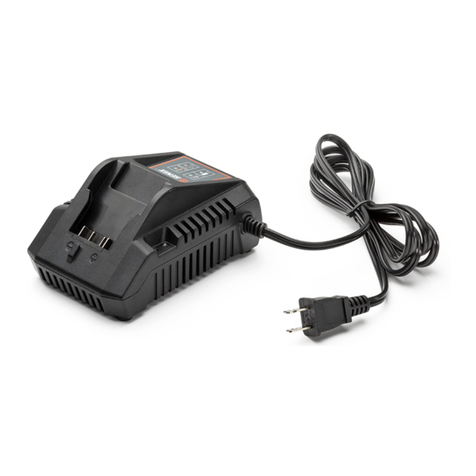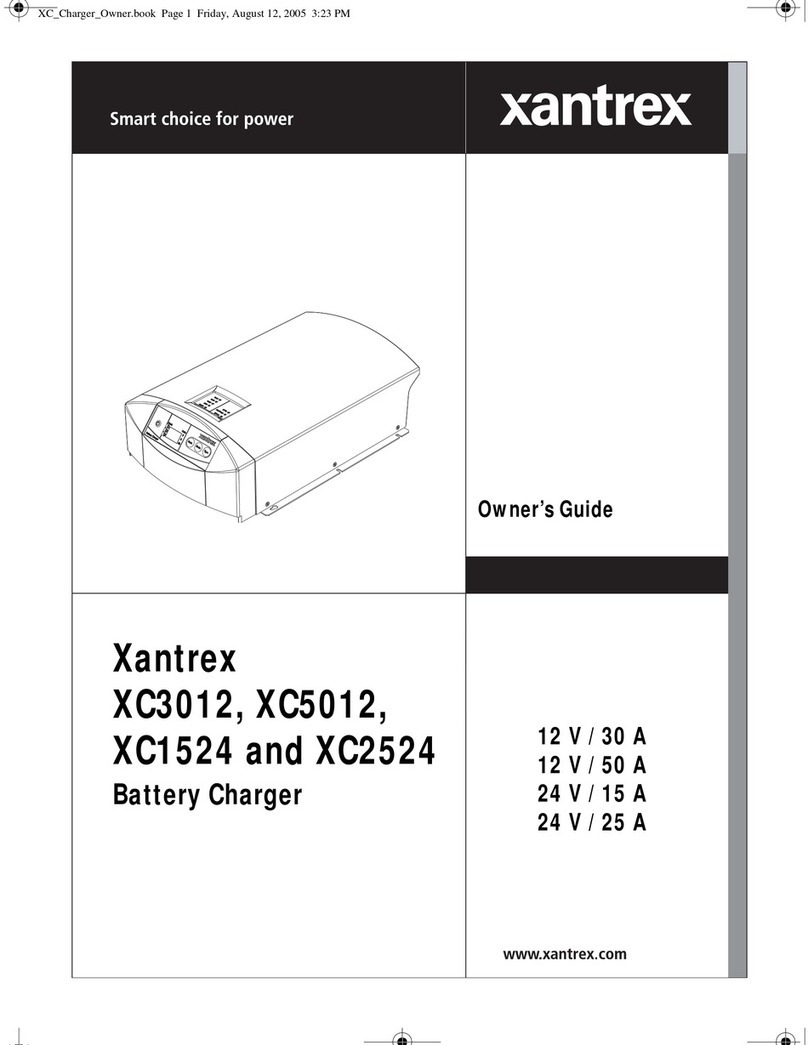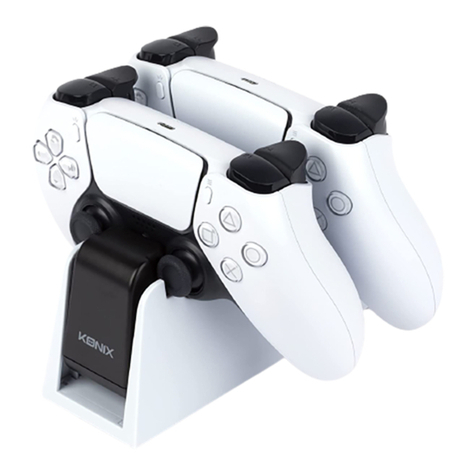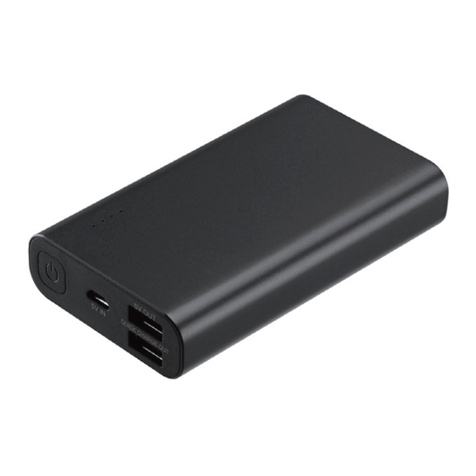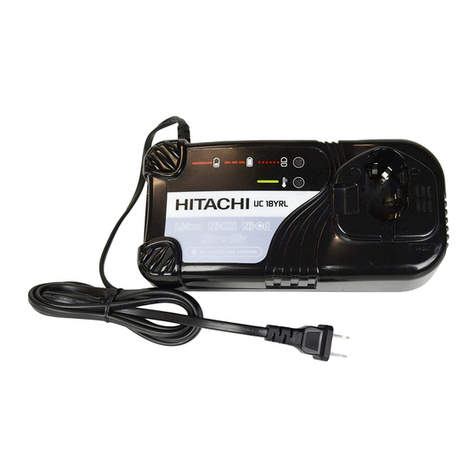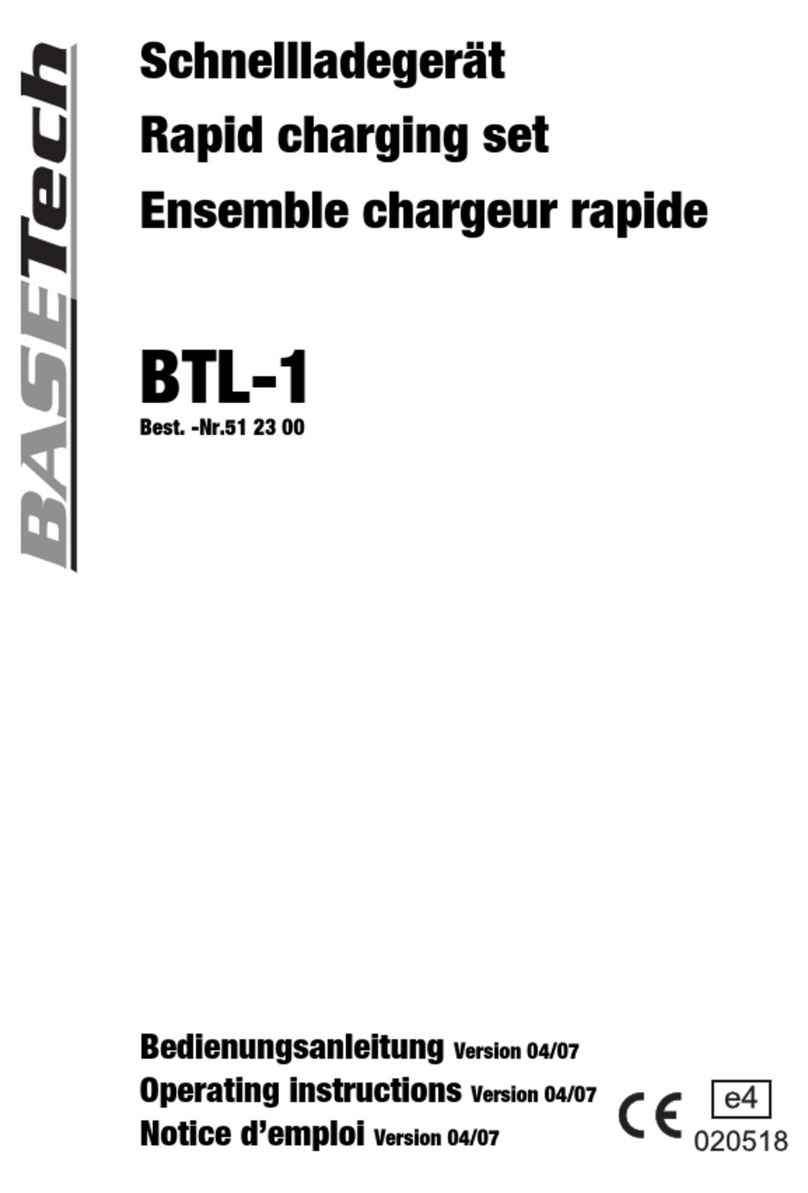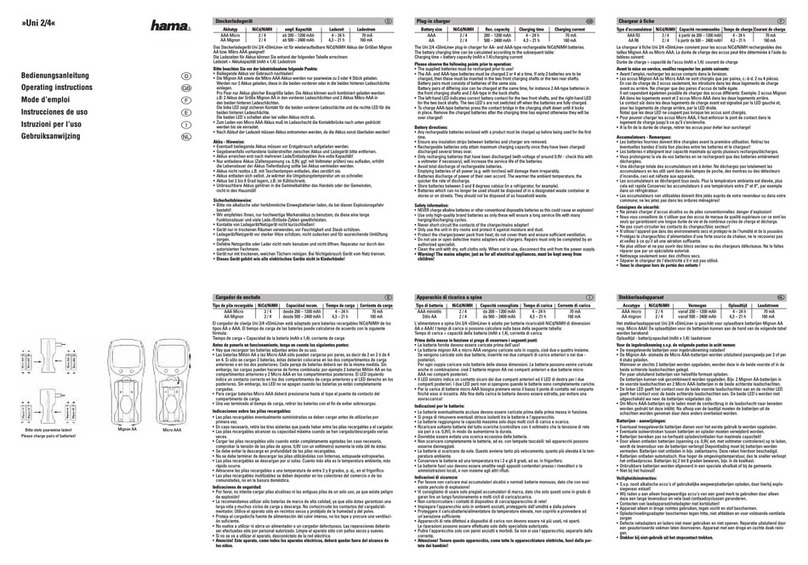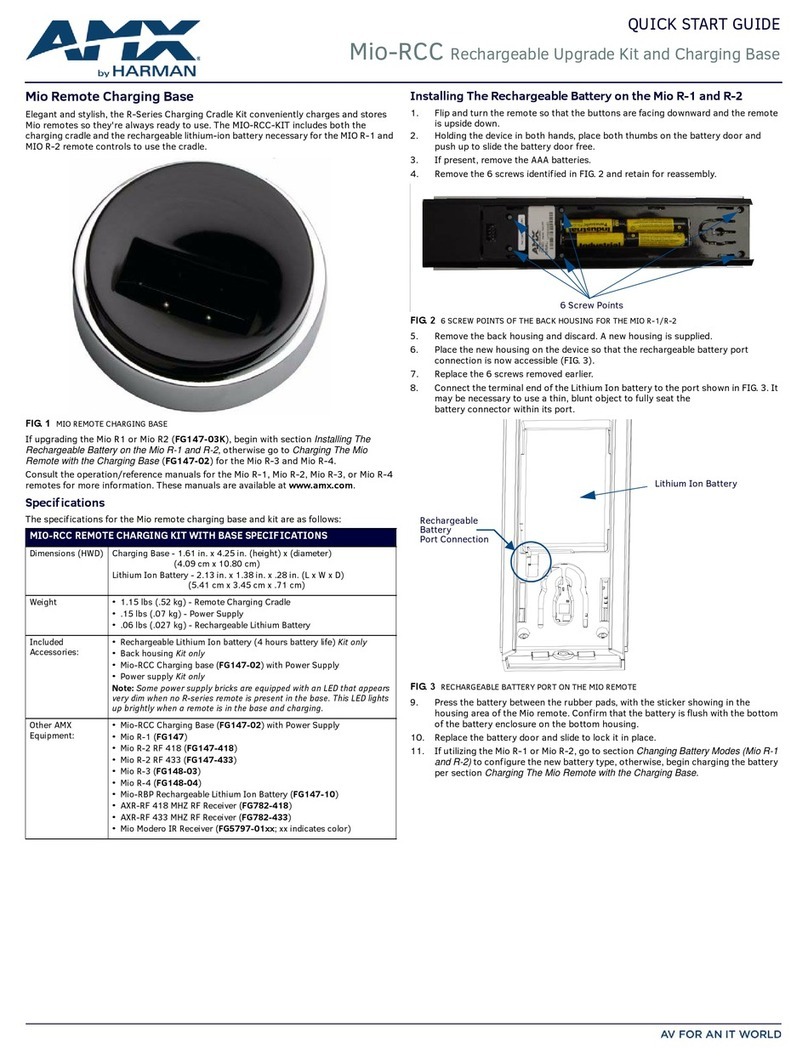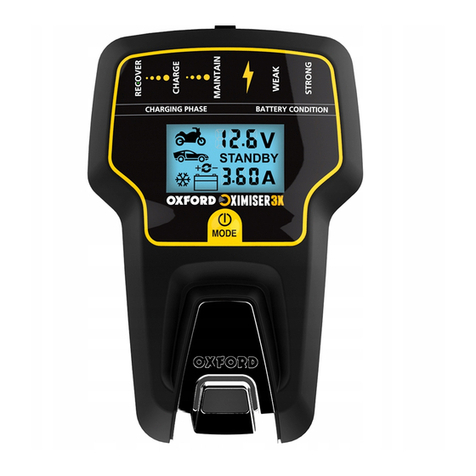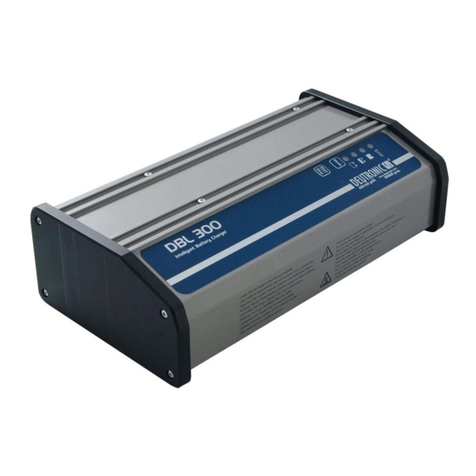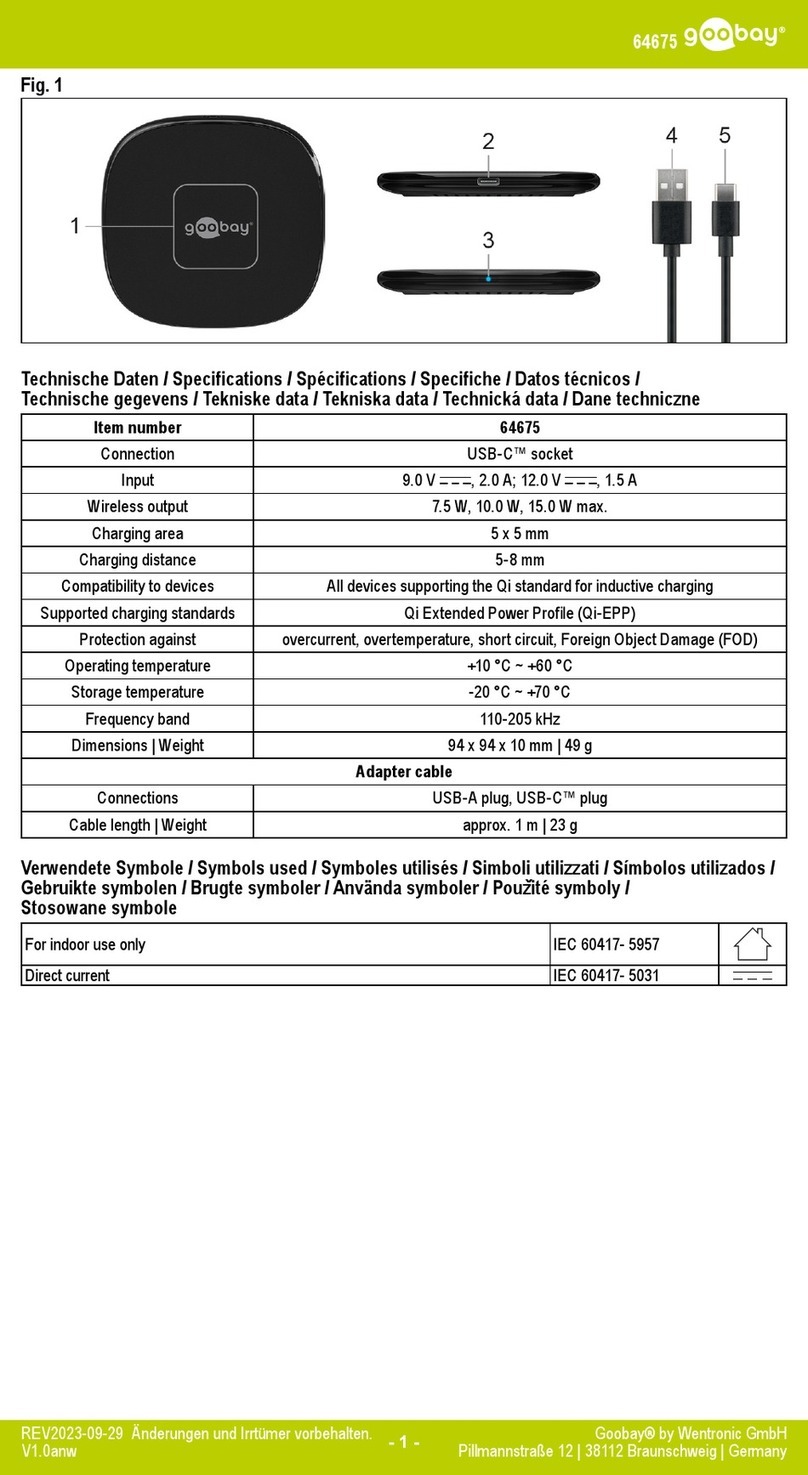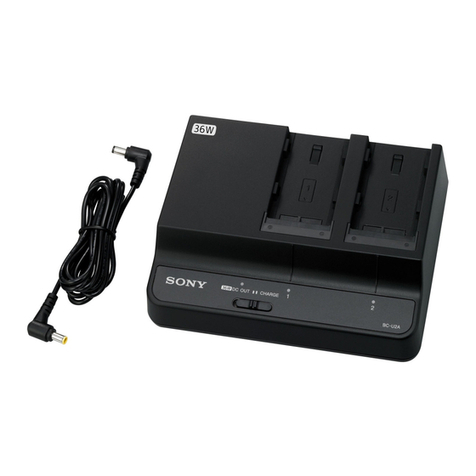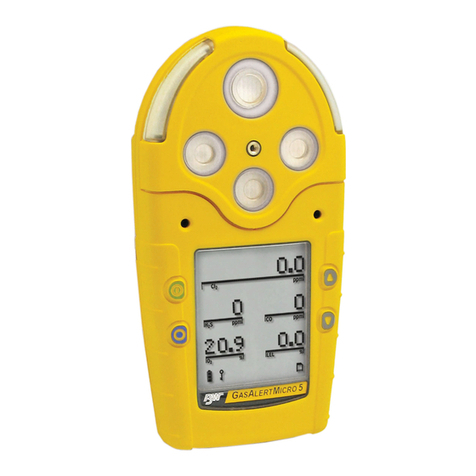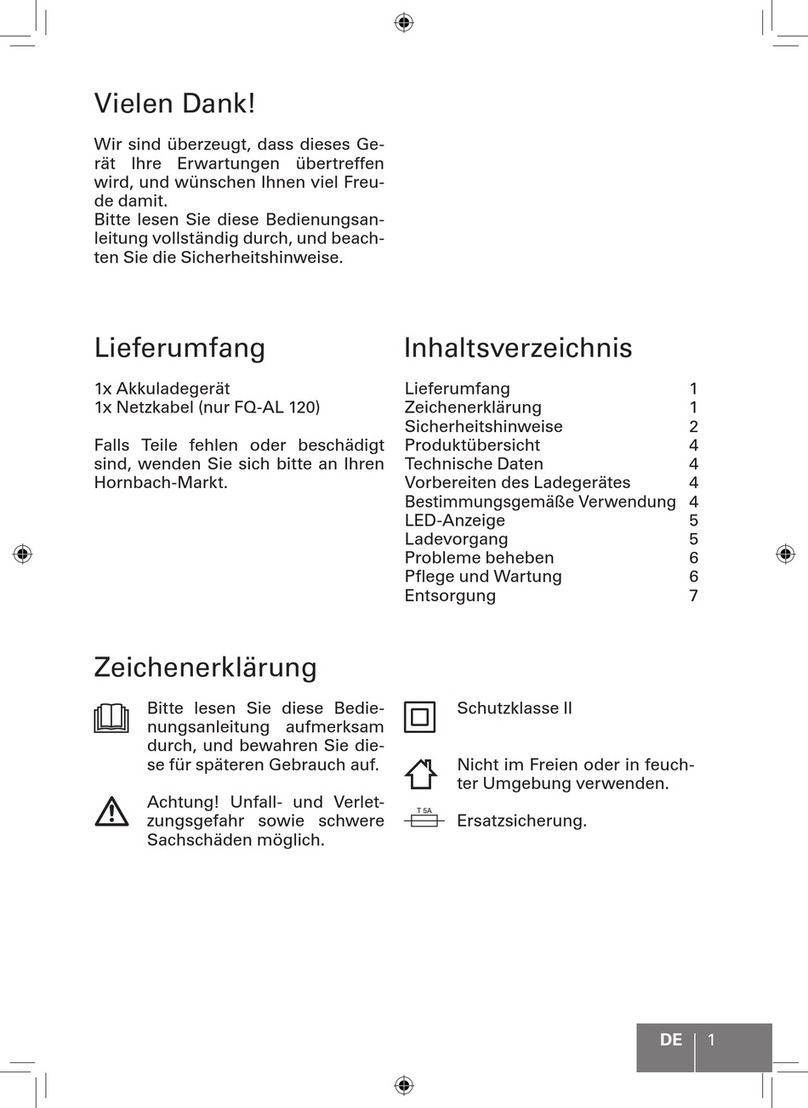Senix CHX5 User manual

Operator’s manual
Model: CHX5
For customer support, please call 1-800-261-3981 or send email to:
SAVE THIS MANUAL FOR FUTURE REFERENCE.

2WWW.SENIXTOOLS.COM
TABLE OF CONTENTS TECHNICAL DATA
SAFETY
MAINTENANCE
WARRANTY
ELECTRICAL INFORMATION
TECHNICAL DATA..................................................2
ABOUT THE BATTERY...........................................4
CHARGER..............................................................4
DISPOSAL...............................................................5
Model Number:
Charger Input:
Charger Output:
Weight:
Product
Dimensions:
Compatible with:
Battery:
CHX5
120V AC, 60Hz, 145W
58V DC, 2A
1.43
lbs.
7.9 x 4.6 x 3.2 in.
(200 x 117 x 81 mm)
Battery Model B25X5
58V Max Lithium Ion,
2.5 Ah
To reduce the risk of injury, user
1. SAVE THESE INSTRUCTIONS – This
manual contains important safety
and operating instructions for battery
charger Model CHX5.
2. Before using battery charger, read all
instructions and cautionary markings
on battery charger, battery, and
product using battery.
3. CAUTION – To reduce risk of injury,
charge only B25X5 type rechargeable
batteries. Other types of batteries
may burst causing personal injury and
damage.
IMPORTANT SAFETY
INSTRUCTIONS
Despite all the safety precautions,
caution must always be exercised
when handling batteries. The following
points must be obeyed at all times to
ensure safe use. Safe use can only be
guaranteed if undamaged cells are used.
Incorrect handling of the battery pack
can cause cell damage.
WARNING!
WARNING!
CHARGER...............................................................7
BATTERY STORAGE..............................................7
LIMITED TWO-YEAR WARRANTY..........................8
GROUNDING INSTRUCTIONS..............................6
CONTENTS

3
WWW.SENIXTOOLS.COM
Note: The safe temperature range for
the battery charging is 32°F to 104°F (0
°C to 40 °C). Do not charge the battery
outside in freezing weather; charge it at
room temperature.
SAFETY
• Avoid dangerous environments: Do not
charge the battery pack in rain, snow
or in damp or wet locations. Do not
use the battery pack or charger in the
presence of explosive atmospheres
materials) because sparks may be
generated when inserting or removing
the battery pack, which could lead to
• Charge in a well-ventilated area: Do
not block the charger vents. Keep them
clear to allow for proper ventilation. Do
a charging battery pack. Vented gases
may explode.
• Maintain charger cord: When
unplugging the charger, pull the plug,
not the cord, from the receptacle
to reduce the risk of damage to the
electrical plug and cord. Never carry
the charger by its cord or yank it by
the cord to disconnect it from the
receptacle. Keep the cord away from
heat, oil and sharp edges. Make sure
the cord will not be stepped on, tripped
over or subjected to damage or stress
when the charger is in use. Do not
use the charger with a damaged cord
or plug. Replace a damaged charger
immediately.
• Do not use an extension cord unless
it is absolutely necessary: Using the
wrong, damaged or improperly wired
electric shock. If an extension cord
must be used, plug the charger into
a properly wired 16 gauge or larger
extension cord with the female plug
matching the male plug on the charger.
Make sure that the extension cord is in
good electrical condition.
• Charger is rated for 120 volt AC only:
The charger must be plugged into an
appropriate receptacle.
• Use only recommended attachments:
Use of an attachment not
recommended or sold by Senix may
personal injury.
• Unplug charger when not in use: Make
sure to remove battery packs from
unplugged chargers.
WARNING!
• Do not burn or incinerate battery packs:
Battery packs may explode, causing
personal injury or damage. Toxic fumes
and materials are created when battery
packs are burned.
• Do not crush, drop or damage battery
packs: Do not use the battery pack or
charger if they have sustained a sharp
blow, been dropped, run over or have
been damaged in any way (i.e. pierced
with a nail, hit with a hammer, stepped
on, etc.).
• Do not disassemble: Incorrect
reassembly may pose a serious risk
totoxic battery chemicals. If the battery
or charger are damaged, call Senix
customer service at
1-800-261-3981 for assistance.
• Battery chemicals cause serious burns:
Never let a damaged battery pack
contact the skin, eyes or mouth. If a
damaged battery pack leaks battery
chemicals, use rubber or neoprene
gloves to safely dispose of it. If skin
affected area with soap and water and
rinse with vinegar. If eyes areexposed
with water for 20 minutes and seek

4WWW.SENIXTOOLS.COM
SAFETY
medical attention. Remove and dispose
of contaminated clothing.
• Do not short circuit: A battery pack will
short circuit if a metal object makes
a connection between the positive
and negative contacts on the battery
pack. Do not place a battery pack
near anything that may cause a short
circuit, such as paper clips, coins,
keys, screws, nails and other metallic
objects. A short-circuited battery pack
injury.
• Store your battery pack and charger
in a cool, dry place: Do not store
the battery pack or charger where
temperatures may exceed 104 °F (40
°C), such as in direct sunlight or inside
a vehicle or metal building during the
summer.
ABOUT THE BATTERY
• The battery pack supplied with your
cordless tool is only partially charged.
The battery pack has to be charged
completely before you use the tool for
• For optimum battery performance,
avoid low discharge cycles by charging
the battery pack frequently.
• Lithium-ion batteries are subject to
a natural aging process. The battery
pack must be replaced at the latest
when its capacity falls to just 80% of
its capacity when new. Weakened cells
in an aged battery pack are no longer
capable of meeting the high power
requirements needed for the proper
operation of your tool, and therefore
pose a safety risk.
• Do not throw battery packs into an
explosion. Do not ignite the battery
• Do not exhaustively discharge
batteries. Exhaustive discharge
will damage the battery cells. The
most common cause of exhaustive
discharge is lengthy storage or non-use
of partially discharged batteries. Stop
working as soon as the performance
of the battery falls noticeably or the
electronic protection system triggers.
Place the battery pack in storage only
after it has been fully charged.
• Protect batteries and the tool from
overloads. Overloads will quickly
result in overheating and cell damage
inside the battery housing even if this
overheating is not apparent externally.
• Avoid damage and shocks.
Immediately replace batteries that have
been dropped from a height of more
than one meter or those that have been
exposed to violent shocks, even if the
housing of the battery pack appears to
be undamaged. The battery cells inside
the battery may have suffered serious
damage. In such instances, please
read the waste disposal information for
proper battery disposal.
• If the battery pack suffers overloading
and overheating, the integrated
protective cutoff will switch off the
equipment for safety reasons.
• Use only original battery packs. The
risk and may result in injuries or an
explosion.
Protect the battery charger and its cord
from damage. Keep the charger and
its cord away from heat, oil and sharp
edges. Electrical plugs must match the
outlet. Never modify the plug in any
way. Do not use any adapter plugs with
and matching outlets will reduce the risk
of electric shock.
Keep the battery charger, battery pack(s)
and the cordless tool out of the reach of
children. Do not use the supplied battery
charger to charge other cordless tools.
During periods of heavy use, the battery
pack will become warm. Allow the
battery pack to cool to room temperature
before inserting it into the charger to
CHARGER

5
WWW.SENIXTOOLS.COM
SAFETY
recharge.
Do not overcharge batteries. Do not
exceed the maximum charging times.
These charging times only apply to
discharged batteries. Frequent insertion
of a charged or partially charged battery
pack will result in overcharging and cell
damage. Do not leave battery in the
charger for days on end. Never use or
charge a battery if you suspect that it
has been more than 12 months since
the last time they were charged. There
is a high probability that the battery
pack has already suffered dangerous
damage (exhaustive discharge). Do not
use battery that have been exposed
to heat during the charging process,
as the battery cells may have suffered
dangerous damage. Do not use
battery that have suffered curvature or
deformation during the charging process
or those that exhibit other atypical
symptoms (gassing, hissing, cracking,
etc.)
USAGE
1. This power unit is intended to be
correctly orientated in a vertical or
2. Connect the connector pin of battery
current power supply.
3. When in charge process, the charging
indicator lightshows red; after fully
charged, the charging indicator light
shows green.
4. When the batteries are fully charged,
(When the Green light is on), unplug
the connector pin of alternating
that of battery.
TROUBLE REMOVAL
DISPOSAL
Lithium-ion batteries must be disposed
of at a hazardous waste collection point
or battery recycling location, NOT with
household waste.
1. The power indicator light does not
illuminate.
A. Check whether there is alternating
current power supply.
B. Check whether the connection is
bad at the input interface.
When you eliminate the conditions
above, please ask for help from the
WARNING!
manufacturers: do not attempt to
repair it by yourself.
2. The charging indicator light is not
work.
A. Check whether the output
connector is well connected.
B. Check whether the battery can be
used.
When you eliminate the conditions
above, please ask for help from the
manufacturers; do not attempt to
repair it by yourself.
3. The charging indicator light is always
red.
A.See whether the battery is
damaged.
When you eliminate the conditions
above, please ask for help from the
manufacturers; do not attempt to
repair it by yourself.

6WWW.SENIXTOOLS.COM
ELECTRICAL INFORMATION
IN THE EVENT OF A MALFUNCTION OR
BREAKDOWN,
grounding provides the path of least
resistance for an electric current and reduces
the risk of electric shock. This tool is equipped
with an electric cord that has an equipment
grounding conductor and a grounding plug.
The plug MUST be plugged into a matching
outlet that is properly installed and grounded
in accordance with ALL local codes and
ordinances.
DO NOT MODIFY THE PLUG PROVIDED. If
installed by alicensed electrician.
IMPROPER CONNECTION of the equipment
grounding conductor can result in electric
shock. The conductor with the green
insulation (with or without yellow stripes) is
the equipment grounding conductor. If repair
or replacement of the electric cord or plug is
necessary, DO NOT connect the equipment
grounding conductor to a live terminal.
CHECK with a licensed electrician or
service personnel if you do not completely
understand the grounding instructions or
whether the tool is properly grounded.
GROUNDING INSTRUCTIONS
Make sure your extension cord is in good
condition. When using an extension cord, be
sure to use one heavy enough to carry the
current your product will draw. An undersized
cord will cause a drop in line voltage resulting
in loss of power and overheating. The table
below shows the correct size to be used
according to cord length and nameplate
ampere rating. When in doubt, use a heavier
cord. The smaller the gauge number, the
GUIDELINES FOR EXTENSION
CORDS
CAUTION!
WARNING!
WARNING!
heavier the cord.
Make sure your extension cord is properly
wired and in good condition. Always replace
a damaged extension cord or have it repaired
Protect your extension cords from sharp
objects, excessive heat and damp/wet areas.
Use a separate electrical circuit for your tools.
This circuit must not be less than a #12 wire
and should be protected with a 15 A time-
delayed fuse. Before connecting the motor
to the power line, make sure the switch is in
the OFF position and the electric current is
rated the same as the current stamped on the
motor nameplate. Running at a lower voltage
will damage the motor.
2.5 A
25 ft. 50 ft. 100 ft. 150 ft.
18 gauge 16 gauge 14 gauge 12 gauge

7
WWW.SENIXTOOLS.COM
MAINTENANCE
MAINTENANCE
CHARGER
BATTERY STORAGE
WARNING!
If you need to repair or replace the battery or
charger, contact Senix customer service at
1-800-261-3981.
• Keep the charger clean and clear of debris.
Do not allow foreign material to get into the
recessed cavity or onto the contacts. Wipe
the charger clean with a dry cloth. Do not
use solvents or water, and do not place the
charger in wet conditions.
• Unplug the charger when there is no battery
in it.
• Fully charge the battery before placing it in
storage.
• Store the charger at normal room
temperature. Do not store it in excessive
heat. Do not use the charger in direct
sunlight or in damp conditions. Do not
charge outside. Recharge at room
temperature. If the battery is hot, allow it to
cool down before recharging.
• To maximize the life of the battery, Fully
charge before storage.
• After charging, the battery pack may be
stored in the charger, as long as the charger
is not plugged in.
• Do not store the battery pack on the tool.
• Store the battery in a clean, dry place. Cover
it in order to provide added protection.
• When battery pack is not in use, keep it
away from other metal objects like paper
clips, coins, keys, nails, screws, or other
small metal objects that can make a
connection from one terminal to another.

8WWW.SENIXTOOLS.COM
WARRANTY
WARRANTY
LIMITED TWO-YEAR WARRANTY
2-year limited warranty on all Senix X5 series outdoor battery powered equipment and charger.
2-year limited warranty on all Senix X5 batteries.*
FOR TWO YEARS from the original date of retail purchase this Senix product is warranted
against defects in materials or workmanship on power tools and chargers. Defective product will
receive free repair.*
FOR TWO YEARS from the original date of retail purchase this Senix product is warranted
against defects in materials or workmanship on batteries. Defective product will receive free
repair.*
This warranty does not cover normal wear of parts and components such as cutting chain, line
or blades nor does this warranty cover product transportation cost for warranty or service.
for a particular purpose, are limited to three years from the date of purchase on power tools and
chargers and seven years on batteries. The manufacturer is not responsible for direct, indirect,
incidental or consequential damages. Some states and provinces do not allow limitations on
how long an implied warranty lasts and/or do not allow the exclusion or limitation of incidental
damages, so the above limitations and exclusions may not apply to you. This warranty gives
province to province.
The YAT USA declines any responsibility in regard to civil liability arising from abusive use or not
in conformity with proper use and maintenance of the machine as described in the operator’s
manual.
YAT USA is not responsible for direct, indirect, incidental or consequential damages.
After the purchase, the manufacturer recommends proper maintenance of the machine and to
read the operator’s manual before using the machine.
*Original purchase receipt may be required for proof of purchase
For customer service contact us toll free at 1-800-261-3981 or Senixtools.com.
YAT USA, Inc. 6441 Hendry Rd. Suite A Charlotte, NC. 28269
To locate your nearest Senix service provider call toll free at 800-261-3981 or email us at
service@senixtools.com.
Warranty is subject to the following conditions:
• Warranty applies to the original purchaser at retail and is not transferrable*
• Warranty Registration at www.senixtools.com
other than an authorized service center
• Only genuine Senix accessories have been used with or on this product
• The tool has been subjected to normal wear and tear
• The tool has not been used for trade or professional purposes
• The tool has not been used for rental purposes
• This warranty only covers defects arising under normal usage and does not cover any
malfunction, failure or defect resulting from misuse, abuse (including overloading the product,
exposure to water or rain) accidents, neglect or lack of proper installation and improper
maintenance or storage.

Manual del operador
Modelo: CHX5
Si desea ponerse en contacto con el Servicio al cliente, llame al número 1-800-261-3981 o envíe un email a:
CONSERVE ESTE MANUAL PARA FUTURAS CONSULTAS.

10 WWW.SENIXTOOLS.COM
DATOS TÉCNICOS
SEGURIDAD
Número de modelo:
Entrada del cargador:
Salida del cargador:
Peso:
Dimensiones del
producto:
Compatible con:
Batería:
CHX5
120V AC, 60Hz, 145W
58V CC, 2A
1.43
lbs.
7,9 x 4,6 x 3,2 pulgadas
(200 x 117 x 81 mm)
Modelo de batería B25X5
Ion de litio de 58V Máx., 2,5 Ah
¡ADVERTENCIA!
¡ADVERTENCIA!
ÍNDICE
MANTENIMIENTO
GARANTÍA
INFORMACIÓN ELÉCTRICA
DATOS TÉCNICOS..............................................10
ACERCA DE LA BATERÍA....................................12
CARGADOR..........................................................13
ELIMINACIÓN.......................................................14
CARGADOR..........................................................16
ALMACENAMIENTO DE LA BATERÍA...................16
GARANTÍA LIMITADA DE DOS AÑOS...................17
INSTRUCCIONES DE TOMA A TIERRA................15
CONTENIDO
1. CONSERVE ESTAS
INSTRUCCIONES – Este manual
contiene importantes medidas
de seguridad e instrucciones de
funcionamiento del cargador de
baterías modelo CHX5.
2. Antes de utilizar el cargador de
baterías, lea las instrucciones y los
marcajes de advertencia ubicados
en el cargador de baterías, en las
baterías y en el producto que funciona
a baterías.
3. PRECAUCIÓN – Para disminuir el
riesgo de sufrir lesiones, cargue solo
baterías recargables de tipo B25X5.
Otros tipos de baterías podrían
estallar y causar lesiones personales
y daños.
MEDIDAS IMPORTANTES
DE SEGURIDAD

11
WWW.SENIXTOOLS.COM
A pesar de todas las medidas de
seguridad siempre deberá tomar
precauciones al manipular baterías.
Para asegurar un uso seguro en todo
momento, siga estos puntos. Un uso
seguro solo se puede garantizar si
se utilizan células no dañadas.Una
manipulación incorrecta del paquete de
baterías puede dañar las células.
SEGURIDAD
• Evite entornos peligrosos: No cargue
el paquete de baterías bajo la lluvia,
nieve o en lugares húmedos o
mojados. No utilice el paquete de
baterías o el cargador en presencia de
atmósferas explosivas (gases, polvo o
generarse chispas al insertar o extraer
la batería y se podría producir un
incendio.
• Cargar en lugar bien ventilado: No
bloquee las ranuras del cargador.
Manténgalas despejadas para que
tengan una ventilación adecuada.
No permita que se fume ni que haya
llamas abiertas cerca del paquete de
baterías cuando está cargándose. Los
gases podrían estallar.
La gama segura de temperatura
para cargar baterías es de 32°F a 104°F
(de 0 °C a 40 °C). No cargue la batería
en el exterior si la temperatura está
por debajo de cero grados; cárguela a
temperatura ambiente.
• Mantenimiento del cable de carga:
Al desenchufar el cargador, tire
del enchufe, no tire del cable, para
sacarlo del receptáculo y reducir
el riesgo de dañar el enchufe y el
cable. Nunca transporte el cargador
por el cable ni lo jale por el cable
para desconectarlo del receptáculo.
Mantenga el cable alejado del calor,
de que no se pise, tropiece o someta
el cable a daños o a tensiones cuando
esté usando el cargador. No use el
cargador con un cable o enchufe
dañado. Reemplace un cargador
dañado inmediatamente.
• No utilizar alargaderas de corriente a
menos que sea totalmente necesario:
El uso de una alargadera de corriente
incorrecta, dañada o de cableado
inadecuado presenta riesgos de que
se produzcan fuegos y descargas
eléctricas. Si fuera necesario utilizar
una alargadera de corriente, enchufe
el cargador a una de calibre 16 o
mayor debidamente conectada con un
enchufe hembra que coincida con el
que la alargadera de corriente está en
buenas condiciones eléctricas.
• El cargador es de CA 120 voltios
únicamente: El cargador debe
enchufarse a un receptáculo
apropiado.
• Usar únicamente los accesorios
recomendados: El uso de accesorios
no recomendados o vendidos por
Senix puede causar riesgos de
fuegos, descargas eléctricas y
lesiones corporales.
• Desenchufar el cargador cuando
no se esté utilizando: Retire los
paquetes de baterías de cargadores
desenchufados.
¡ADVERTENCIA!
• No quemar o incinerar los paquetes
de baterías: Los paquetes de baterías
podrían estallar y causar lesiones
personales o daños. Cuando se
queman paquetes de baterías se
producen humos y materiales tóxicos.
• No aplastar, dejar caer o dañar los

12 WWW.SENIXTOOLS.COM
SEGURIDAD
paquetes de baterías: No utilice el
paquete de baterías o el cargador si
han sufrido un golpe fuerte, se han
caído, han sufrido un accidente o se
han dañado de algún modo (es decir,
perforado con un clavo, golpeado con
un martillo, pisado, etc.).
• No desarmar: Un armado incorrecto
presenta riesgos de que se produzcan
descargas eléctricas, fuegos o la
exposición a los productos químicos
de la batería. Si la batería o el
cargador se dañan, llame al servicio al
cliente de Senix al número 1-800-261-
3981 para que le aconsejen.
• Los productos químicos de las
baterías producen quemaduras
graves: Nunca permita que un
paquete de baterías dañado entre en
contacto con la piel, los ojos o la boca.
Si el paquete de baterías tiene fugas
de productos químicos, use guantes
de goma o neopreno para desecharlo
de modo seguro. Si los líquidos de
la batería entran en contacto con la
piel, lave la zona afectada con agua y
jabón y enjuáguela con vinagre. Si el
líquido de la batería entra en contacto
con los ojos, lávelos inmediatamente
con agua durante 20 minutos y
consulte con un médico.
Retire y deseche la ropa contaminada.
• No cortocircuite los terminales: Un
paquete de baterías entrará en
cortocircuito si se conectan los polos
positivo y negativo con un objeto
metálico. No ubique el paquete
de baterías cerca de objetos que
pudieran causarle un cortocircuito,
tales como clips para papel, monedas,
llaves, tornillos, clavos o cualquier
otro objeto de metal. Un paquete de
baterías en cortocircuito presenta un
riesgo de que se produzca un fuego y
lesiones personales graves.
• Almacene el paquete de baterías y
el cargador en lugar fresco y seco:
No almacene el paquete de baterías
o el cargador en lugares donde la
temperatura pueda ser superior a 104
°F (40 °C), como bajo la luz del sol o
metal en verano.
ACERCA DE LA BATERÍA
• El paquete de baterías suministrado
con su herramienta inalámbrica solo
está parcialmente cargado. Antes de
usar la herramienta por primera vez,
cargue completamente el paquete de
baterías.
• Para obtener el mejor desempeño,
no realice ciclos bajos de carga
cargando el paquete de baterías
frecuentemente.
• Las baterías de ion de litio tienen un
proceso natural de envejecimiento.
El paquete de baterías deberá
reemplazarse cuando su capacidad
caiga al 80% de su capacidad
inicial. Las células debilitadas de un
paquete de baterías envejecido ya
no son capaces de cumplir con los
requisitos de alta potencia necesarios
para el correcto funcionamiento
de su herramienta y, por lo tanto,
representan un riesgo para la
seguridad.
• No eche los paquetes de baterías
al fuego porque podrían estallar. No
incinere el paquete de baterías ni lo
exponga al fuego.
• No deje descargar las baterías
demasiado. Una descarga excesiva
dañará las células de las baterías. La
causa más común de una descarga
excesiva de las baterías es cuando se
almacenan parcialmente cargadas o
no se utilizan por largos periodos de
tiempo.
Deje de operar tan pronto como
observe que el desempeño de la
si se activa el sistema de protección
electrónica. Almacene el paquete de
baterías solo después de cargarlo
completamente.

13
WWW.SENIXTOOLS.COM
SEGURIDAD
• Proteja las baterías y la herramienta
contra sobrecargas.
Las sobrecargas producen
sobrecalentamientos y dañan
las células del interior de la
carcasa de la batería, incluso si el
sobrecalentamiento no es aparente en
el exterior.
• Evite daños y golpes. Reemplace
de inmediato las baterías que hayan
caído al suelo desde una altura
superior a un metro, o aquellas
que hayan sido sometidas a golpes
violentos, incluso si su carcasa no
presenta daños. Las células del
interior de la batería pueden haber
sufrido daños serios. En tales
circunstancias, lea la información
sobre el desecho correcto de baterías.
• Si el paquete de baterías sufre una
sobrecarga y un sobrecalentamiento,
el interruptor de protección de corte
de suministro integrado apagará el
equipo por razones de seguridad.
• Use solo paquetes de baterías
originales. El uso de otras baterías
presenta un riesgo de que se
produzcan fuegos que podrían causar
lesiones o explosiones.
Proteja el cargador y su cable contra
daños.
Mantenga el cargador y su cable
alejados del calor, aceites y bordes
ser adecuados para el tomacorriente.
alguno. No utilice enchufes adaptados
con herramientas con toma a tierra.
coincidan perfectamente con sus
correspondientes tomacorrientes
reducirán los riesgos de sufrir descargas
eléctricas.
Mantenga el cargador, el/los paquete(s)
de baterías y la herramienta inalámbrica
fuera del alcance de los niños. No
CARGADOR USO
1. Este cargador está hecho para para
orientarse correctamente en una
posición de armado vertical o sobre
el piso.
2. Conecte la clavija del conector de la
carcasa de la batería primero, y a
continuación, conecte el suministro
de corriente alterna.
3. Durante el proceso de carga, la
luz indicadora de carga se ilumina
en rojo; una vez completamente
cargada, la luz indicadora de carga
se ilumina en verde.
4. Cuando las baterías estén
completamente cargadas, (cuando la
luz verde está iluminada), desenchufe
la clavija del conector de la corriente
use el cargador incluido para cargar
otras herramientas inalámbricas.
Durante periodos de uso continuado,
el paquete de baterías se calentará.
Deje que el paquete de baterías se
enfríe a temperatura ambiente antes de
insertarlo en el cargador para recargarlo.
No sobrecargue las baterías. No
sobrepase los tiempos máximos de
carga. Estos tiempos de carga solo
son aplicables a baterías descargadas.
Una inserción frecuente de una batería
cargada o parcialmente cargada
producirá una sobrecarga y dañará
las células. No deje la batería en el
cargador durante días. Nunca use
o cargue una batería si piensa que
pasaron más de 12 meses desde la
última recarga. Es muy posible que
el paquete de baterías haya sufrido
daños peligrosos (descarga exhaustiva).
No utilice baterías que hayan estado
expuestas al calor durante su recarga
ya que las células podrían haber sufrido
daños peligrosos. No use baterías que
se hayan curvado o deformado durante
el proceso de recarga, o aquellas que
presenten anomalías (gases, silbidos,
grietas, etc.).

14 WWW.SENIXTOOLS.COM
SEGURIDAD
ELIMINACIÓN
RESOLUCIÓN DE PROBLEMAS
Las baterías de ion de litio deben
desecharse en un punto de recolección
de residuos peligrosos o en una
instalación de reciclaje de baterías, NO
con los residuos domésticos.
¡ADVERTENCIA!
1. Este cargador está hecho para para
orientarse correctamente en una
posición de armado vertical o sobre
el piso.
2. Conecte la clavija del conector de la
carcasa de la batería primero, y a
continuación, conecte el suministro
de corriente alterna.
3. Durante el proceso de carga, la
luz indicadora de carga se ilumina
en rojo; una vez completamente
cargada, la luz indicadora de carga
se ilumina en verde.
4. Cuando las baterías estén
completamente cargadas, (cuando la
luz verde está iluminada), desenchufe
la clavija del conector de la corriente
alterna primero, y después el
conector de la carcasa de la batería.
alterna primero, y después el
conector de la carcasa de la batería.

15
WWW.SENIXTOOLS.COM
INFORMACIÓN ELÉCTRICA
EN CASO DE FUNCIONAMIENTO
ANÓMALO O AVERÍA, la toma a tierra
ofrece el camino más fácil a la corriente
eléctrica y disminuye el riesgo de que
se produzcan descargas eléctricas. La
herramienta posee un cable eléctrico que
posee un conductor y un enchufe equipados
con toma a tierra. El enchufe DEBE estar
enchufado a un tomacorriente adecuado que
esté correctamente instalado y conectado a
tierra de acuerdo con TODOS los códigos y
ordenanzas locales.
NO MODIFICAR EL ENCHUFE
SUMINISTRADO Si no encaja en el
tomacorriente, pida a un electricista
Una CONEXIÓN INCORRECTA del equipo
de conducción a tierra podría ocasionar
una descarga eléctrica. El conductor con el
aislamiento verde (con o sin rayas amarillas)
es el conductor de toma a tierra del equipo.
Si es necesario reparar o reemplazar el
cable eléctrico o el enchufe, NO conecte el
conductor de tierra del equipo a un terminal
bajo tensión.
o con personal de servicio si no entiende
completamente las instrucciones o si no
sabe si la herramienta está correctamente
conectada a tierra.
INSTRUCCIONES DE TOMA
en buenas condiciones eléctricas. Cuando
use una alargadera de corriente, asegúrese
DIRECTRICES PARA ALARGADERAS
DE CORRIENTE
¡ATENCIÓN!
¡ADVERTENCIA!
¡ADVERTENCIA!
para llevar la corriente que requiere su
provocará una caída en el voltaje de la línea,
lo que resultará en pérdida de potencia
y sobrecalentamiento. La siguiente tabla
muestra el tamaño correcto que se utilizará
de acuerdo con la longitud del cable y la
capacidad de amperaje de la placa de
más pesado. Cuanto menor es el número de
calibre, más pesado es el cordón.
Asegúrese de que su alargadera esté
correctamente conectada y en buenas
condiciones. Reemplace siempre una
alargadera dañada o hágala reparar por una
Proteja las alargaderas de corriente contra
húmedos/mojados.
Use un circuito eléctrico separado con
sus herramientas. Este circuito no debe
ser menor que un cable # 12 y debe estar
protegido con un fusible de 15 A con demora
de tiempo. Antes de conectar el motor a la
línea de alimentación, asegúrese de que el
interruptor esté en la posición de apagado
(OFF) y la corriente eléctrica tenga la misma
un voltaje más bajo dañará el motor.
2.5 A
25 pies 50 pies 100 pies 150 pies
Calibre 18 Calibre 16 Calibre 14 Calibre
12
(7,62 m) (15,24 m) (30,48 m) (45,72 m)

16 WWW.SENIXTOOLS.COM
MANTENIMIENTO
MANTENIMIENTO
CARGADOR
ALMACENAMIENTO DE LA
BATERÍA
¡ADVERTENCIA!
Si necesita reparar o reemplazar el cargador
de baterías, contacte con el servicio al cliente
de Senix llamando al número 1-800-261-
3981.
• Mantenga el cargador limpio y sin residuos.
No permita que se introduzcan materiales
extraños en la cavidad empotrada o en los
contactos. Limpie el cargador con un paño
seco. No use disolventes o agua, y no lo
ubique en lugares húmedos.
• Desenchufe el cargador cuando no esté
cargando la batería.
• Cargue completamente la batería antes de
almacenarla.
• Almacene el cargador a temperatura
ambiente. No lo almacene en lugares
demasiado cálidos. No use el cargador bajo
la luz directa del sol o en ambientes con
alta humedad. No lo recargue en exteriores.
Recárguelo a temperatura ambiente. Si la
batería está caliente, déjela enfriar antes de
recargarla.
• Cargue completamente la batería antes de
almacenarla para extender al máximo su
vida útil.
• Después de cargar, el paquete de baterías
puede almacenarse en el cargador siempre
que no esté enchufado.
• No guarde el paquete de baterías en la
herramienta.
• Almacene la batería en lugar limpio y seco.
Cúbrala para protegerla.
• Cuando no esté utilizando la batería,
manténgala apartada de objetos metálicos
tales como clips para papeles, monedas,
llaves, clavos, tornillos, o de cualquier
otro objeto metálico pequeño que pudiera
conectar un terminal con otro.

17
WWW.SENIXTOOLS.COM
GARANTÍA
GARANTÍA LIMITADA DE DOS AÑOS
Garantía limitada de 2 años para todos los equipos y baterías de exterior de la serie Senix
X5. Garantía limitada de 2 años para todas las baterías Senix X5*. DURANTE DOS AÑOS a
partir de la fecha original de compra, este producto Senix está garantizado contra defectos de
materiales o mano de obra en herramientas eléctricas y cargadores. Los productos defectuosos
serán reparados de modo gratuito.* DURANTE DOS AÑOS a partir de la fecha original de
compra, este producto Senix está garantizado contra defectos de materiales o mano de obra en
baterías. Los productos defectuosos serán reparados de modo gratuito.* Esta garantía no cubre
el desgaste normal de piezas y componentes tales como, la sierra de corte, línea o cuchillas, ni
cubre el costo de transporte bajo garantía o servicio.
Cualquier garantía implícita adicional otorgada bajo la ley estatal, incluidas las garantías de
comerciabilidad o idoneidad para un propósito particular, está limitada a tres años desde
la fecha de compra en herramientas eléctricas y cargadores y siete años en baterías. El
fabricante no es responsable por daños directos, indirectos, incidentales o consecuentes.
Algunos estados y provincias no permiten limitaciones sobre la duración de una garantía
implícita y/o no permiten la exclusión o limitación de daños incidentales, por lo que es posible
que las limitaciones y exclusiones anteriores no sean aplicables en su caso. Esta garantía
aplicables, los cuales varían entre estados o provincias.
YAT USA declina toda responsabilidad con respecto a la responsabilidad civil derivada de un
uso abusivo o que no esté en conformidad con el uso y el mantenimiento adecuados de la
herramienta según se describe en el manual del operador.
YAT USA no es responsable por daños directos, indirectos, incidentales o consecuentes.
Después de la compra, el fabricante recomienda el mantenimiento adecuado de la herramienta
y leer el manual del operador antes de usarla.
* Es posible que se requiera un recibo de compra original como comprobante de compra. Para
servicio al cliente contáctenos gratis llamando al número 1-800-261-3981 o Senixtools.com.
YAT USA, Inc. 6441 Hendry Rd. Suite A Charlotte, NC.28269
Para conocer la ubicación de su servicio Senix más cercano, llame gratis al número 800-261-
3981 o envíe un email a service@senixtools.com.
La garantía está sujeta a las condiciones siguientes:
• La garantía es aplicable al comprador original al por menor y no es transferible*
• Registro de garantía en www.senixtools.com
reparada por nadie que no sea un centro de servicio autorizado.
• Solo se han utilizado accesorios originales Senix con este producto o en el mismo.
• La herramienta ha sufrido un desgaste normal.
• Esta garantía solo cubre defectos que aparecen durante el uso normal y no cubre ningún mal
funcionamiento, falla o defecto resultante de un mal uso, abuso (incluyendo sobrecarga del
producto, exposición al agua o lluvia) accidentes, negligencia o falta de instalación adecuada
y mantenimiento o almacenamiento incorrectos.
GARANTÍA

Manuel d’instructions
Modèle: CHX5
Pour joindre le service d'assistance aux consommateurs, veuillez appeler au 1-800-261-3981 ou envoyez un e-mail à :
CONSERVEZ CE MANUEL POUR TOUTE CONSULTATION ULTÉRIEURE.

19
WWW.SENIXTOOLS.COM
DONNÉES TECHNIQUES
Numéro de modèle:
Entrée du chargeur:
Sortie du chargeur:
Poids:
Dimensions du
produit:
Compatible
uniquement avec:
Batterie:
CHX5
120V AC, 60Hz, 145W
58V DC, 2A
1.43
lbs.
7.9 x 4.6 x 3.2 pouces
(200 x 117 x 81 mm)
Modèle de batterie
B25X5
Lithium Ion 58 V Max, 2.5 Ah
TABLE DES MATIÈRES
TABLE DES MATIÈRES
ENTRETIEN
GARANTIE
INFORMATIONS ÉLECTRIQUES
DONNÉES TECHNIQUES....................................19
À PROPOS DE LA BATTERIE..............................21
CHARGEUR..........................................................22
MISE AU REBUT...................................................23
CHARGEUR..........................................................25
STOCKAGE DE LA BATTERIE...............................25
GARANTIE LIMITÉE À DEUX ANS.........................26
INSTRUCTIONS DE MISE À LA TERRE.................24
1. CONSERVEZ CES INSTRUCTIONS
- Ce manuel contient d'importantes
instructions de sécurité et d'utilisation
concernant le modèle de chargeur de
batterie CHX5.
2. Avant d'utiliser le chargeur de batterie,
lisez toutes les instructions et les
mises en garde sur le chargeur de
batterie, la batterie et le produit
utilisant la batterie.
3. ATTENTION - Pour réduire les risques
de blessure, chargez uniquement
des batteries rechargeables de
type B25X5. D'autres types de piles
pourraient éclater, causant des
blessures sur des personnes et des
dommages sur les biens.
INSTRUCTIONS IMPORTANTES
DE SÉCURITÉ
SÉCURITÉ
AVERTISSEMENT !
AVERTISSEMENT !

20 WWW.SENIXTOOLS.COM
Despite all the safety precautions,
caution must always be exercised
when handling batteries. The following
points must be obeyed at all times to
ensure safe use. Safe use can only be
guaranteed if undamaged cells are used.
Incorrect handling of the battery pack
can cause cell damage.
Une manipulation incorrecte de la
batterie peut endommager les cellules.
• Évitez les environnements dangereux.
Ne chargez pas la batterie sous la
pluie, la neige ou dans des endroits
humides ou mouillés. N'utilisez pas
la batterie ou le chargeur dans une
atmosphère explosive (exposée à des
vapeurs gazeuses, des poussières
des étincelles pourraient se produire
lors de l'insertion ou du retrait de la
batterie, ce qui pourrait provoquer un
incendie.
• Rechargez la batterie dans un endroit
bien aéré : Ne bloquez pas les
ventilations du chargeur. Gardez-les
propres pour permettre une ventilation
adéquate. Ne laissez pas de la fumée
batterie en charge. Les gaz ventilés
peuvent exploser.
sources de chaleur, de l’huile et des
arêtes coupantes. Assurez-vous de
ne pas marcher ni trébucher sur le
câble et qu'il ne soit pas exposé à
des dommages ou soumis à des
contraintes lorsque le chargeur
est en cours d'utilisation. N'utilisez
pas le chargeur avec un câble ou
une prise endommagé. Remplacez
immédiatement le chargeur s'il est
endommagé.
N’utilisez pas de rallonge électrique,
sauf en cas d’absolue nécessité.
L'utilisation d'une rallonge incorrecte,
endommagée ou mal câblée présente
un risque d'incendie et d'électrocution.
Si une rallonge doit être utilisée,
branchez le chargeur dans une
rallonge de calibre 16 ou plus avec
vous que la rallonge est en bon état
électrique.
• Le chargeur est adapté à une tension
de 120 volts CA seulement: Le
chargeur doit être branché dans une
prise appropriée.
• Utilisez uniquement les accessoires
recommandés: L'utilisation d'un
accessoire non recommandé ou
qui n'est pas vendu par Senix peut
entraîner un risque d'incendie, de
choc électrique ou de blessure.
• Débranchez le chargeur lorsqu'il n'est
pas utilisé: Assurez-vous de retirer
la batterie du chargeur lorsqu'il est
débranché.
SÉCURITÉ
Il est recommandé
de recharger la batterie lorsque la
température ambiante est comprise
entre 32°F to 104°F (0 °C to 40 °C). Ne
chargez pas la batterie à l'extérieur par
temps de gel; Chargez-la à température
ambiante.
• Entretenez le câble du chargeur :
Lorsque vous débranchez le chargeur,
saisissez la prise et ne tirez pas sur
la prise ou le câble d'alimentation.
Ne transportez jamais le chargeur
en le tenant par son câble et ne tirez
par sur le câble pour le déconnecter
de la prise. Veillez à ce que le câble
d'alimentation reste éloigné des
Pour réduire tout risque de choc
AVERTISSEMENT !
Table of contents
Languages:
Other Senix Batteries Charger manuals
